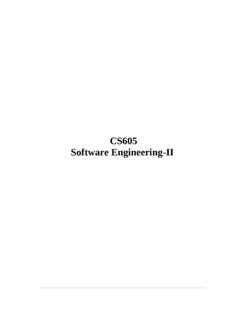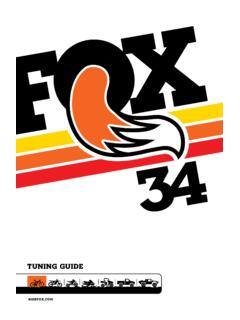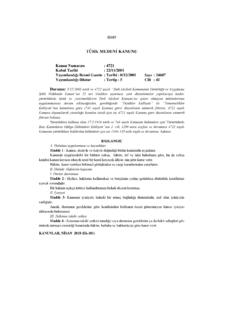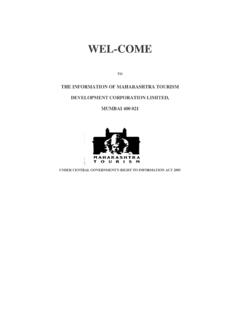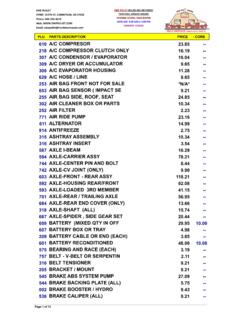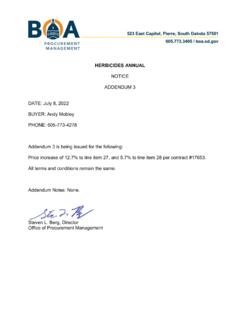Transcription of BY ORDER OF THE SECRETARY AIR FORCE INSTRUCTION 24 …
1 DEPARTMENT OF THE AIR FORCE HEADQUARTERS UNITED STATES AIR FORCE WASHINGTON, DC AFI24-605V5_AFGM2022-01 29 November 2022 MEMORANDUM FOR DISTRIBUTION C MAJCOMs/FLDCOM/FOAs/DRUs FROM: HAF USAF/A4L 1030 Air FORCE Pentagon Washington 20330-1030 SUBJECT: Air FORCE Guidance Memorandum (AFGM) to Air FORCE INSTRUCTION (AFI) 24-605, Volume 5, Air Transportation Standardization and Resources By ORDER of the SECRETARY of the Air FORCE (SecAF), this AFGM immediately changes AFI 24-605, Volume 5, Air Transportation Standardization and Resources. Compliance with this memorandum is mandatory. This publication does not apply to the United States Space FORCE .
2 To the extent its directions are inconsistent with other United States Air FORCE publications, the information herein prevails, in accordance with DAFMAN 90-161, Publishing Processes and Procedures. Ensure all records created as a result of processes prescribed in this publication are maintained in accordance with AFI 33-322, Records Management and Information Governance Program, and disposed of in accordance with the Air FORCE Records Disposition Schedule (RDS) located in the Air FORCE Records Management System. This memorandum provides interim Night Vision Goggle (NVG) training guidance for the Air Transportation (2T2X1) Air FORCE Specialty. NVG training is designed to qualify air transportation individuals assigned to an in-garrison mission and/or meet a deployment requirement.
3 This Memorandum becomes void after one-year has elapsed from the date of this Memorandum, or upon publication of an Interim Change or rewrite of AFI 24-605, Volume 5, Air Transportation Standardization and Resources, whichever is earlier. LINDA S. HURRY, Maj Gen, USAF Director of Logistics DCS/Logistics, Engineering & FORCE Protection Attachment: AFI 24-605V5_AFGM2022-01 Attachment AFI24-605V5_DAFGM2022-01 INTERIM NIGHT VISION GOGGLE TRAINING GUIDANCE Section 2K Night Vision Goggle (NVG) Training Requirements General. Night Vision Goggle training is designed to qualify Total FORCE individuals assigned to an in-garrison mission and/or meet deployment requirements.
4 Course completion qualifies personnel to operate in low-light airlift ground operations. (T-2). The Night Vision Goggle Operator/Instructor Course (NVGOIC) is available to Total FORCE members at any of the following locations: 19th Logistics Readiness Squadron, Little Rock Air FORCE Base, AR. 622d Transportation Readiness Squadron/Transportation Proficiency Center (TPC), Dobbins Air Reserve Base, GA. 165th Airlift Wing, Savannah Air National Guard Base, GA. 435th Contingency Response Squadron (CRS) Ramstein AB, Germany. 305th Aerial Port Squadron, Joint Base McGuire-Dix-Lakehurst, NJ. 647th Logistic Readiness Squadron Combat Mobility Flight (LRS/CMF), Joint Base Pearl Harbor-Hickam, HI.
5 The two-day Night Vision Goggle Operator/Instructor Course consists of three phases: Phase I: Initial Familiarization Training. Personnel will be trained in proper inspection, operation, and use of NVGs utilizing Headquarters Air FORCE approved learning material. (T-2). Phase II: Vehicle Operation. Personnel will operate vehicles in a controlled low-light environment using NVGs. (T-2). Tasks will focus on core airlift ground operations to improve trainee situational awareness, communications, and functional coordination in preparation for Phase III. (T-2). Vehicle training will be done on a K-loader or 10K All-Terrain (AT) forklift during static loading/off-loading operations.
6 (T-2). For static training, practice with static loads such as highline docks or flatbed trailers. (T-2). Phase III consists of engine running on-load/off-load (ERO) operations conducted in low-light conditions with NVGs. (T-2). Ensure every opportunity is taken to conduct Phase III ERO training. (T-2). When the lack of aircraft are available to train, with aircraft engines running, NVG instructors may use static aircraft. When using static aircrafts, instructors must make training as realistic as possible to replicate an ERO training environment. If unable to conduct ERO operations use a highline dock or K-loader to replicate training and load teams will use hand signals only for communication.
7 Verbal communication will only be utilized to stop unsafe operations. (T-2). C-17 reduced lighting ERO clarification, in accordance with AFMAN 11-2C-17V3, C-17 Operations Procedures. MHE operators may utilize NVGs up to final parking position to enhance situational awareness. (T-2). If the mission set requires minimum or reduced light uploads/downloads, loadmasters will use proper light discipline. (T-2). Blacked out (no-light) operations or covert uploads/downloads are not authorized. (T-2). Roles and Responsibilities. Headquarters Air FORCE (HAF). The Air Transportation Career Field Manager (CFM) will function as Office of Primary Responsibility (OPR) and have administrative authority over Air Transportation NVG program guidance.
8 The CFM will collaborate with Air Mobility Command (AMC), Air FORCE Reserve Command (AFRC), National Guard Bureau (NGB) and Air FORCE Installation Mission and Support Center (AFIMSC) to: Develop standardized NVG curriculum. Develop and provide course critiques to NVG instructors. Plan, coordinate, and organize NVG Workshops as needed for the purpose of collaborating and updating training materials. When applicable, conduct an NVG program review during unit effectiveness inspections or other staff visits to the unit. For TPC registration utilize the SharePoint page. SharePoint address: For RegAF and NGB locations, utilize your Unit Training Manager (UTM) for registration.
9 UTMs will utilize AFIMSC Training Request SharePoint Tool for individual registration. NVGOIC Training locations, will serve as the primary certifier for unit level instructors. It may also be used as an alternate location for operator training. The NVGOIC locations will: Administer NVG program in accordance with this INSTRUCTION and refer to applicable registration SharePoint websites for additional program administration information. (T-2). Ensure training courses are established/coordinated in collaboration with AFIMSC, NGB, and TPC to forecast course schedules. (T-2). Update the Master NVG Instructor List located on the AMC/A4TS Training SharePoint page.
10 (T-2). SharePoint address: #/ Maintain updated NVGOIC course lesson plans and course materials. (T-2). Ensure instructors meet NVGOIC prerequisites identified on TTG to include Air Transportation Instructors Course (ATIC). (T-2). NVG Instructors. The NVG Instructor Course (NVGOIC) is a hands-on, train-the-trainer course conducted at three designated locations. Course completion certifies personnel to operate in low-light airlift ground operations and qualifies individuals as a NVGOIC instructor for airlift ground operations. NVG Instructors will: Possess awarded 5-skill level or above (or civilian equivalent). (T-2) Be NVG Phase III qualified.











